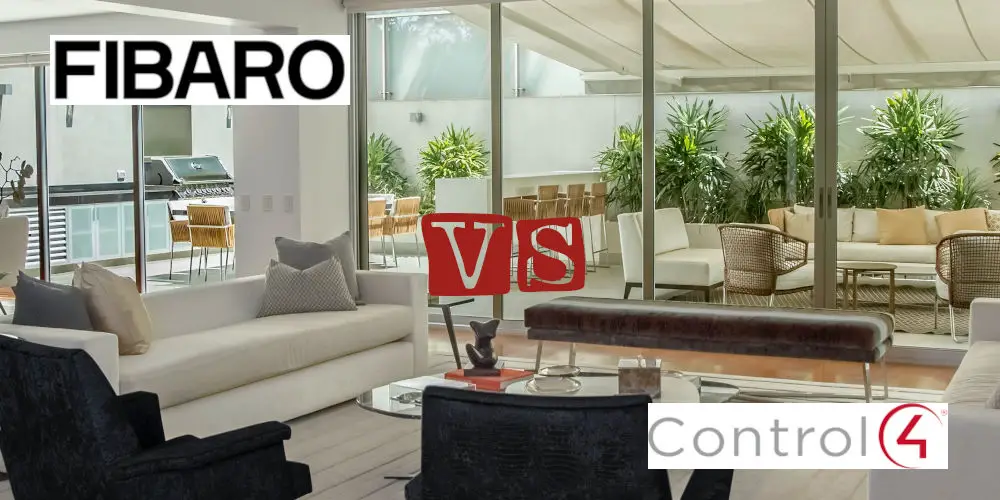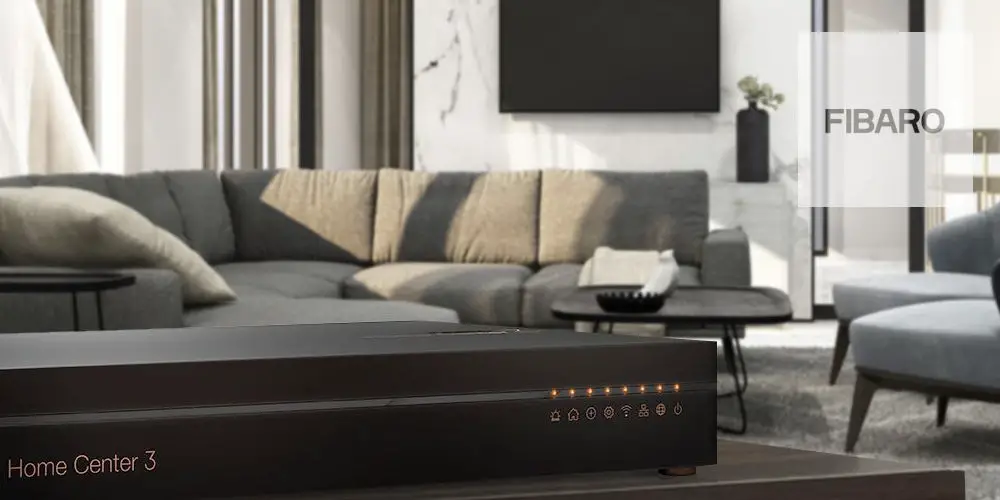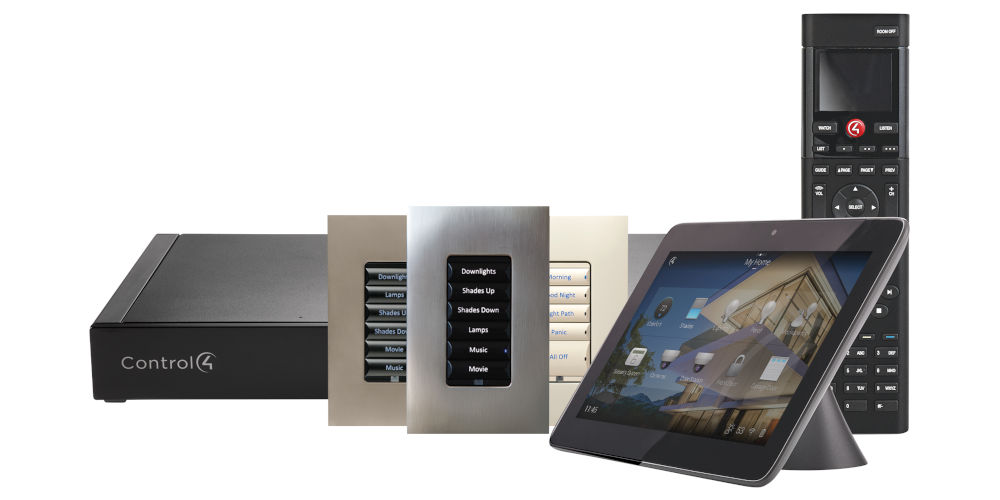Fibaro vs Control4: Your ideal home automation system

After deciding to automate your home, one of the trickiest tasks is deciding what system to use. And while comparing Fibaro vs Control4 might seem odd at the start, it’s worthwhile.
As two of the leading smart home systems currently available, Control4 and Fibaro achieve similar outcomes but use completely different methods.
What makes comparing these systems unique is a Fibaro home automation system uses wireless technology and is DIY friendly. As a wired system, Control4 isn’t directly available to consumers, instead, you have to hire an approved dealer to install and configure the system.
Hopefully, even at this stage, you can see some of the main differences between Fibaro vs Control4.
Let’s tour each system in detail and then try to draw a fair comparison between the two, allowing you to make an informed buying decision.
Fibaro

photo by FIBARO
History
Headquartered in Poznan, Poland, Fibaro launched in 2010. Today, their products can be found in over 100 countries and are affordable to buy. Fibaro is widely considered to be one of the most advanced wireless smart home systems.
Devices are designed around the Z-Wave protocol, allowing them compatibility with thousands of 3rd party devices. All devices work are compatible with the Apple HomeKit protocol, offering even more options to automate your home.
Fibaro offers devices to control every aspect of your home and the system can be operated from anywhere with Wi-Fi. With voice control becoming popular, Fibaro works with both the Google Assistant and Amazon Alexa.
How does Fibaro works?
All devices are built using the Z-Wave chip, allowing for a much wider range than Bluetooth and yet is a lower power alternative to Wi-Fi. Every Fibaro system needs a hub, as this device is the brains that sends and receives control signals to devices.
Use two-way communication, devices can repeat messages and also acknowledge they’ve received messages. As devices have a 30-metre range, the network can adapt itself to ensure signals are routed in the best possible way to avoid any ‘dead-spots’.
Fibaro rigorously tested 3rd party products to ensure seamless integration and ease of use within their eco-system. Also, they continually invest in their app and website.
Is it DIY friendly?
Fibaro offers a good mix of retrofittable and plug-in and play products, allowing you to add the technology to your home without creating an eyesore. Once devices are installed, they need to be paired with the hub for them to work as part of the system.
Current product range
Fibaro offers a solid product range with multiple hubs available (Home Center 2 and 3). They also offer a few different sensors, relays, sockets and even a smart TRV valve that allows you to add smart technology to your radiators.
Not to mention a few controllers including the Swipe, which uses hand motion to activate pre-set scenes, allowing you to control multiple devices with ease. Fibaro even offer a smart intercom, so you can see who’s at the door and communicate with them regardless of where you are!
Also as a Z-Wave compatible system, if Fibaro doesn’t offer a particular product, you can always use a device from a 3rd party brand. There are thousands of Z-Wave compatible products currently on the market! So, you should be able to find a device to complete the task!
Any downsides?
As a wireless smart home system, you’ll likely experience drop-out. However, these should be very rare and only temporary.
With new products being released and old Z-Wave chips discontinued, there will always be the need to update software and firmware. Some have had issues with software releases that have resulted in having to reprogram the system or restore software to a previous version.
Even as a Z-Wave compatible system, not every 3rd party device will work with Fibaro, despite what the packaging says. Before buying any devices, you’ll need to do some research to ensure they will interact without issue.
An area where Fibaro has room for improvement is audio and video. There are several audio system that integrate into Fibaro using Quick Apps but not every system does and there’s only limited TV integrations, which is frustrating.
Control4

photo by Control4
History
Since launching in 2004, Control4 has established itself as a leading provider of home automation systems for both homes and businesses. Based in Salt Lake City, USA, the company operates through a global network of nearly 6,000 authorized dealers.
Each system is unique as it’s built around the client and their requirements. Control4 can help automate and control connected devices. You can use the system to control features such as lighting, audio, video, climate control, intercom, and security.
To buy a Control4 system, you have to use one of their approved dealers as products aren’t available directly to consumers. The dealer will install and configure the system, creating a bespoke smart home.
In addition to a superb range of products, the Control4 operating system now works with tens of thousands of third-party products. Over the years, they have cemented their place as a leader in the market by acquiring several companies such as Pakedge, Triad, Neeo and others.
Around 475,00 homes worldwide use a Control4 system with more than 15 million connected devices.
How does Control4 works?
Control4 is a predominantly wired system, usually requiring your home to be rewired. Devices are wired into rack-mounted modules that control the system. However, the majority of the controllers are wireless and battery-powered.
Many wireless devices including Sonos smart speakers, for example, can be effortlessly integrated within a system, allowing the user access to a wider set of functions. The system even works with Google Assistant!
As a wired system that requires programming from the ground up, unless you’re a highly trained engineer, it’s near impossible to install alone. It’s why they have dealers all over the world! That said, once installed, a Control4 system is rock solid.
Since you can’t buy products off the shelf, the only way to negotiate a good deal is by playing two dealers off each other. Buying a control4 system is completely different from asking a local electrician to install a few smart sockets!
If you were to compare two homes with a Control4 system, you’d quickly realise that each will act differently depending on the homeowner’s demands and requirements.
Is it DIY friendly?
As a wired system, it’s far from DIY friendly. Unless you know what you’re doing or have endless time to research, you’ll need to hire a dealer or installer who understands how to install and configure the Control4 ecosystem. Typically, this isn’t cheap as it’s a highly specific skill.
If you think you can buy second-hand devices from eBay and rewire your home, then you’re in for a shock. Plus, it’s unlikely you could ever cobble a system together from what’s available on eBay, even if you waited a while.
So you’ll need to work with one of their dealers from conception to configuration.
Current product range
Designed to be a complete home automation system, Control4 offers something unique as it can help you control your lights, power, security, media and more. It’s truly a comprehensive solution.
On top of the Control4 branded products, they have worked with a range of 3rd party manufacturers. You, therefore, have access to an even wider range of products that seamlessly integrate with the system.
As long as it’s a repetitive task, you should be able to automate it with Control4. You can even connect all of your TVs to your Control4 system, then be able to pause and move rooms while taking the show with you!
Any downsides?
Due to it being a wired system, installing a Control4 smart home involves rewiring your home. So, if you live in a historic or listed property, you might struggle to actually install a Control4 system.
Another issue with having to run cables throughout your home is doing so isn’t cheap. The labour cost alone quickly adds up, not to mention buying the cables and equipment.
As a closed dealers network, they expect that you’ll spend a sum of over £50,000. So, it’s hardly a system you would install on a whim or give it go yourself. Nor should you expect your system to be installed and working overnight.
Buying Control4 products is costly. Even finding the latest price list is tricky as dealers don’t want to be knocked down on price or have clients trying to remove features to save money.
You can’t update the system or products with new software and firmware, so you’ll need your dealer to send their engineer out to apply the latest updates.
Fibaro vs Control4
Having looked at both of the systems in detail, you might wonder which is better? So, let’s compare Fibaro vs Control4.
Fibaro
Fibaro is highly affordable, DIY friendly and easy to configure. As products use the Z-Wave chip, you have access to thousands of products off the shelf. Once you have a Fibaro hub, you can slowly add elements to form a home automation system, allowing you to go at your own pace.
That said, support can be patchy and you might have to do a lot of research. You might struggle to integrate different manufacturers products into your system, even if they should be compatible.
As Fibaro uses a phone app, you could experience drop-outs or issues if your Wi-Fi stops.
Control4
On the other hand, Control4 is highly flexible and delivered by dealers who pride themselves on providing excellent support and an unrivalled buying experience.
As a closed system, products are rigorously tested before being released. Many third party products are put through the same process to ensure they fully work with Control4. Being a wired system, it doesn’t need Wi-Fi to work.
That said, an internet connection helps extend the system’s functions and control. So you shouldn’t experience any dropouts or connection issues.
When you buy a Control4 system, someone else takes care of the details and issues, allowing you to return to an installed and configured system, without any hassle. Of course, this comes at a high price, not to mention running a Control4 system can be expensive.

Picking a winner: Fibaro vs Control4!
While both Control4 and Fibaro achieve the same basic outcome of automating your home, their methods are completely different. So one way to settle the Fibaro vs Control4 debate is to look at your property’s value.
If you live in a modern property that’s worth over £750,000, then you’ll likely have the budget to install a Control4 system. Should your home be worth under this figure, then Fibaro might be ideal.
In a historic home, the idea of having to rewire it may send shivers down your spine. So rather than having to battle with the planners to get a Control4 system approved, stick to Fibaro.
Fibaro is fantastic if you’re just starting your smart home journey as you can build the system at your own pace. Whereas if you have the budget and know exactly what features you’d like automated and don’t fancy having to install a thing, then Control4 is for you.
Hopefully, that settles the debate between Fibaro vs Control4.




